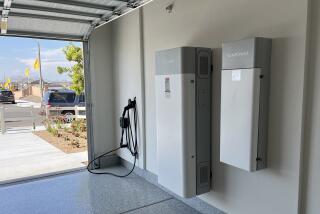Generate Your Own Electricity
- Share via
QUESTION: I have always been intrigued by generating my own electricity with a windmill. Are there residential-size units available? Can I sell any excess electricity it generates back to my utility company?
ANSWER: There are many sizes of electric-generating windmills available for homes. Some inexpensive tiny models are portable and weigh only 13 pounds. These are also ideal for a backyard workshop, camping and on boats or RVs.
One tiny model, Air Wind, has a 45-inch diameter rotor (blade) and can be mounted on a roof. It produces a maximum of 300 watts and starts producing electricity in only a 5-mph wind.
Another 20-pound portable windmill quickly collapses to be carried under your arm. It uses a 41-inch one-piece natural poplar rotor. With a direct-drive generator (no gears needed), it is practically maintenance free.
Depending on your budget, you can install a small windmill to produce just a fraction of the electricity your family requires or a larger one to supply most of your electric needs. Once installed, it produces free electricity for many years.
At times when your windmill produces more electricity than you need, some utility companies will purchase the extra electricity from you. If it is a small amount, they often allow your electric meter to run in reverse. If you produce a lot extra, they buy it, but at a discounted price.
All windmills have overspeed protection for high-wind stormy weather. Some automatically tilt back in high wind and others rotate out of the wind.
A typical whole-house residential-size windmill has a rotor blade diameter of 20 feet and a rated output of about 10,000 watts of electricity. An automatic computerized “brain” controls the electricity output and frequency to match your utility company’s output. A small windmill can power refrigerators, lights, TVs, power tools, etc.
The ideal system attaches to car-type batteries and includes a small solar photovoltaic panel. On calm, sunny days, the PV panel powers the system.
Before you invest in a larger whole-house windmill, check the typical wind conditions in your area to determine its feasibility. Just a small increase in wind speed from 10 to 18 mph can quadruple the electricity output.
If you have an electric water heater, the electricity from the windmill can be used to heat the water. This is a very inexpensive method to capture the excess electricity that is not currently being used.
Write for Update Bulletin No. 975 showing a buyer’s guide of 13 whole-house and small portable windmills and solar cell panels, electricity outputs, sizes, features, prices and a wind speed chart for 115 cities and an appliance wattage chart. Please send $2 and a business-size, self-addressed stamped envelope to James Dulley, Los Angeles Times, 6906 Royalgreen Drive, Cincinnati, OH 45244.
A Low-Cost Way to Clean Gutters
Q: Each spring, I spray (and waste) a lot of water trying to flush out my gutters. I’m older and I do not like getting up on a ladder. Is there any simple way to clean them without using all that water?
A: There is a low-cost do-it-yourself water-saving gutter cleaner. Buy enough thick-wall three-quarter-inch PVC pipe to reach 1 foot over your gutter.
Glue a hose coupling onto one end. Glue on two 90-degree elbows with a short straight piece in between them. Glue another short piece to the end elbow to form a “J” shape. Glue a cap on the end. Drill four holes in one side of the cap. These spray water out the side to quickly clean the gutter.
*
Letters and questions to Dulley, a Cincinnati-based engineering consultant, may be sent to James Dulley, Los Angeles Times, 6906 Royalgreen Drive, Cincinnati, OH 45244.
More to Read
Inside the business of entertainment
The Wide Shot brings you news, analysis and insights on everything from streaming wars to production — and what it all means for the future.
You may occasionally receive promotional content from the Los Angeles Times.








